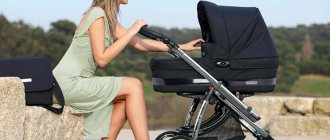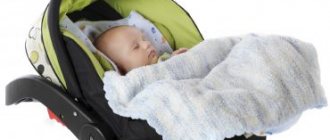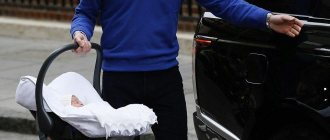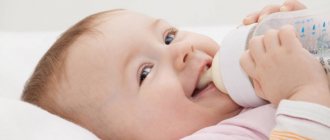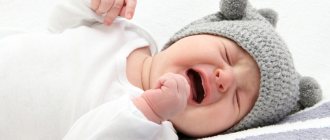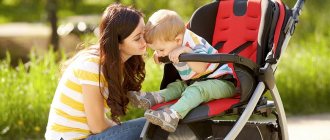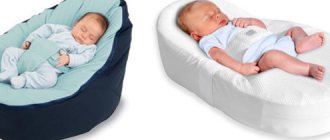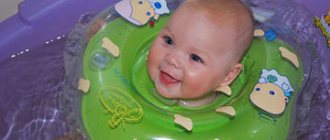When a baby arrives in a family, the question arises: “how to properly transport him in the car?”
Carrying a newborn in arms or in a sling is prohibited. This is very dangerous for the child. After all, his muscles are still weak and his bones are fragile, and with any sharp push from the car he can get injured.
The best option is to purchase a special cradle for newborns in the car, specially designed to protect the newborn from injury and provide him with a comfortable position while driving.
Car seat for newborns: how and where to transport newborns?
A car seat is a special car seat that is designed to transport babies up to one year old. It is orthopedic and has seat belts. A car seat can protect your baby from impacts during accidents.
Why do you need a car seat?
The weight of the infant carrier is 4-5 kg, there is a handle for carrying, and in some models it is possible to attach it to a stroller. It is also possible to have an awning for protection from the sun. The child's position is lying or reclining. It is necessary to have a soft insert to reduce the load on the spine. Backrest tilt is from 30 to 45 degrees. All modern bassinets take into account the developmental features of the baby’s body to achieve the highest level of comfort and safety.
If the infant carrier is attached to the front seat, make sure the airbag is deactivated. Remember that the safest place in the car is behind the driver and in the middle of the back seat, and the most dangerous is in the front.
At what age can you use a car seat?
There are two categories of car cradles: 0 and 0+. Each of them indicates the age of children the infant carrier is intended for.
– 0 – for children up to six months. The peculiarity is that the back is completely horizontal. Ideal for premature babies.
– 0+ – for babies up to one year old.
It is important to note how the infant carrier is installed (the safety of the baby in case of accidents depends on this) - always against the direction of the car. The main advantage of the infant carrier is that the position in it promotes normal breathing of the child.
How does a car seat differ from a car seat?
To compare infant carriers and seats, it is important to remember the body features of infants - slight stiffness of bones, a huge amount of cartilage tissue, weak muscles in comparison with a large head. Based on these factors, we compare the infant carrier with the seat:
1. In the cradle, the child is in a horizontal position (the most correct for small children), and in the car seat the baby is reclining, which slightly reduces comfort.
2. Car seats are intended for children up to 9 kg and 70 cm (not without exceptions), and a seat for children up to 13 kg and 75 cm.
3. The cradle is located perpendicular to the movement of the car and is attached with a standard belt. In the car seat, the child is positioned in the same way, but against the movement.
4. In case of a side impact, the cradle is more dangerous for the baby's head. The child is more protected in the chair. Therefore, when it comes to safety, the car seat is much better.
How to install a car seat correctly
If you purchased a car seat for newborns, learn how to properly attach it in the car to ensure the safest and most comfortable stay for your baby.
1. A car seat for newborns should be installed with the head of the car away from the door to avoid injuries in the event of side impacts.
2. Cradles of category 0+ can be installed in both the rear and front seats. Be sure to install against the direction of the machine. This infant carrier is secured with seat belts or a special system.
3. It may happen that the belts are not long enough. Then they need to be replaced at a service center.
4. To find out how the car seat is attached to the car, just find the installation diagram - it should be drawn in a visible place.
5. Installation will be much easier if you use a stand (base). It can be secured with straps or the Isofix system. It is fixed and then cannot be removed.
Subscribe to our feeds on Facebook, Vkontakte and Instagram: all the most interesting automotive events in one place.
Was this
Categories of car seats for newborns in the car
A wide selection of bassinets allows you to choose a product that fully meets the individual needs of parents and the newborn. Car seat categories “0” or “0+” are specially designed for children from 0 to 18 months.
In the cradle, the child lies in a natural position for him. He does not experience stress on the spine.
Category “0” includes cradles intended for transporting children up to six months. They are quite bulky, but most suitable for a newborn baby. In a crib - a cradle for a newborn, the baby lies as if in a stroller, fastened with a wide belt. Most models can be secured in the rear seat with their side facing the direction of travel.
Category 0 product (photo)
Group “0+” includes car seats (carriers) for transporting children from birth to one year. Thanks to a special design, infant carriers correctly distribute the child’s weight.
Mounted on the rear or front seat facing rearward or facing forward. This is the safest position for the baby.
Portable cradles with stroller attachments
Some baby strollers have a removable unit that doubles as a carrier and car seat. They are multifunctional and portable.
Baby carrier (category 0+)
Happych Oxy Len 3 in 1 stroller with carrier that can be installed in the car
At what age can a child be placed in a car seat?
The task of all conscious and responsible parents is to guarantee their child safety when traveling by car. This can only be done by placing the baby in a special device - a car seat or car seat. They are manufactured taking into account the baby’s physiology and must undergo crash tests to check reliability and safety.
Features of infant carriers
Many young parents confuse an infant carrier and a car seat. A bassinet is like the baby carrier that is often sold with strollers, but it is a little stiffer and has seat belts for the baby. The child can only sit in it in a lying position.
The car seat is usually placed in the back seat and secured with standard seat belts. Mounting methods may vary slightly. While driving, the baby is positioned perpendicular to the road in a horizontal position with a flat back. This is comfortable for babies and promotes normal breathing.
In terms of general safety indicators, infant carriers are significantly inferior to seats. Children are more often injured due to the horizontal position of the body. In addition, moving head first is safer than moving perpendicular to the road due to the structure of the baby's body.
Most stroller manufacturers try to equip removable bassinets and seats with seat belts, and position them as infant carriers. Often, parents, trying to save money, purchase such 3-in-1 or 4-in-1 strollers. It's actually quite dangerous. Most stroller bassinets are not strong enough to protect your baby. In addition, they rarely pass the required crash tests. You should not use such infant carriers for transporting children.
At what age can a child be transported in a car seat?
A cradle is a device designed for little ones. In it, unlike car seats, the baby lies and is not in a semi-sitting position. Many experts believe that it is more comfortable for the child and does not overload the back and neck. Therefore, infant carriers are often recommended for use from birth until 9 months, when the child is already more or less confidently sitting.
It should be noted that no harm has yet been recorded from transportation in car seats, even for newborns. The half-sitting position is physiological for babies and all statements about its dangers are nothing more than the personal opinion of some experts.
As for the question “at what age can a child be placed in a car seat,” the answer here is clear - not at any age. The car seat is not intended for seating. In this position, the child cannot be secured with belts, which means that transporting him will be even more dangerous than in the arms of adults.
What to choose for babies - a baby carrier or a car seat?
If you have the opportunity to choose, it is better to give preference to a high-quality modern car seat of category 0+. Its shape is developed taking into account the anatomical features of the child’s body, so there is no need to worry that a semi-lying position will negatively affect health. The chairs are placed with their backs in the direction of travel, and special pads are used for additional head fixation. Therefore, even in the moment of a strong impact, the car seat protects the child’s neck and spine, but a car seat does not provide such protection. Moreover, the lying position of a child in an accident is considered the most dangerous.
One of the disadvantages of the cradle is its massiveness. When installed, it takes up more than half of the rear seat.
The best choice for the safety of your baby from birth is a high-quality car seat 0+ with a five-point seat belt and special fasteners for attaching to the car. It is also not prohibited to use a car seat for transporting children from birth, but its safety is much lower. Therefore, today cradles are recommended to be used only when there are medical contraindications to transportation in a chair.
Car cradles
At what age can a baby be transported in a car seat? From birth to 6 months.
The child is transported lying down in the cradle. It is installed on the rear seat of the car perpendicular to the movement and secured with car seat belts. In the car seat itself, the child is secured with built-in belts.
In the cradle, the child lies horizontally. The car bed is installed perpendicular to the movement, on the back seat of the car.
The infant carriers are secured with the vehicle's standard seat belts. Strap attachment methods may vary.
The main advantage of infant carriers is that the baby lies horizontally and this maximizes the baby’s normal breathing. The general safety indicators of bassinets are, as a rule, inferior to car seats.
Very often, manufacturers of strollers simply equip removable cradles with additional fasteners, which allows them to be used in a car. But “stroller” car seats, as a rule, are not strong enough to ensure the safety of a child in a car, and therefore are not suitable for transporting infants.
The disadvantages of bassinets include the fact that they take up a lot of space in the car.
Therefore, car bassinets for transporting children should be used only in case of special medical indications.
Car seat for newborn
What types of car seats are there for newborns? Read the article about what to look for when purchasing, how to properly place your baby in a car seat, and what ensures the baby’s safety in the car.
Carrying a newborn in your arms means putting him at risk, even at low speeds! A car seat (car seat) is required for a newborn. Parents need to remember that you cannot use one car seat for a child of all ages.
Safe car seat: where is the guarantee?
The safety of the baby in the car is ensured by the following child car seat parameters:
- protects against side impact. According to numerous studies, it is the side impact that is most dangerous for a small passenger.
- securely attaches to the car. The child must remain secure, including during sudden braking.
- easy operation. According to sad statistics, a significant portion of injuries occur due to improper installation of a child car seat in a car.
Manufacturers of child car seats came to these now obvious things about 30 years ago. Previously, the functions of car seats for newborns and older children were limited to keeping the child in one place while the car was in motion.
But the development of the global automotive industry as a whole, an increase in speeds, the number of cars and increased attention to passenger safety have led to the adoption of uniform European standards for the safety of child car seats. Since 2009, this has been the ECE R44/04 standard, which corresponds to the Russian GOST. Please note that the previous version ECE R44/03 is less stringent than the current one.
The first child car seat appeared in 1935 in America. But then the device did not serve to ensure the safety of the baby in the car, but to prevent the child from crawling around the cabin and interfering with driving.
Innovations for child car seats: ECE and i-size
In the summer of 2013, a new system of standards for child car seats appeared - i-size. The introduction of new markings does not mean that previously manufactured chairs are unsafe. It's all about developing road safety techniques.
i-Size takes into account the latest research, the gradation of car seats has changed relative to the weight and height of the child, and lateral protection has been strengthened. But, at least until 2021, the ECE 44/04 and i-Size standards operate in parallel, which means that car seats marked ECE 44/04, which have already become familiar, will not disappear from Russian stores.
The I-size standard requires that a child car seat be secured in a car exclusively using the isofix system. If your car does not require such special fasteners (this can be clarified in the car modification), then a seat marked i-size will not suit you, only ECE.
Do not confuse ECE R44/04 and Isofix
ECE R44/04 is a child car seat safety standard that includes several parameters regarding side protection, fastening systems, and the dependence of the seat model on height and weight. This marking must be on the car seat.
Isofix is just a fastening system, nothing more. There are two ways to secure a child car seat: using a standard car seat belt and using Isofix anchors.
Make sure that the car seat you choose to purchase has the European marking ECE R44/04. This marking fully complies with Russian GOST standards.
In some countries, for example, in the UK, Israel, Canada, the mother simply cannot be released from the maternity hospital until she guarantees that the newborn will go home in a car seat.
Myths about transporting newborns in a car
The most common belief is that it is supposedly possible to transport a newborn in the arms of an adult or in a regular cradle, especially if the journey is short. Those who claim this point to the fact that they have never heard of car seats for children before, and the driver will be extremely careful. But this is absolutely forbidden! Yes, before there were no car seats for newborns with such a strong and complex protection system as now, but think about how the traffic situation has become more complicated, how much the speed of movement has increased in recent years, and then it will become clear why a child car seat is now vitally important. In addition, a disaster can happen at a relatively low speed of 30-40-50 km/h. Therefore, remember: a newborn can only be transported in a special car seat, regardless of the distance, speed and duration of the trip!
Another myth associated with transporting children in a car is that a car seat for newborns harms the baby’s fragile spine. If you use a car seat for older children to transport a baby, then yes, it is harmful. But special car seats are produced for newborns! They differ from others in that the child is not in a sitting position, but lying down, that is, without any harm to the newborn.
If you do not plan to regularly travel with a newborn in the car, then to move from the maternity hospital home, order a taxi, the fleet of which has not just a car seat for children, but specifically for infants.
Choosing a car seat for a newborn
As mentioned above, a car seat for a newborn differs from others at least in its design, which assumes a semi-lying position for the baby in it. Currently, manufacturers of child car seats use five age categories:
| Category | Child's age | Child's weight (kg) |
| Newborns and up to six months or a year. | ||
| 0+ | From birth to 1.5 years | |
| from 9 months to 3.5-4 years | ||
| 3-7 years | ||
| from 6 years | from 22 |
What you need to know when choosing and using a car seat
The car seat is category 0. Externally, the car seat resembles an ordinary cradle. The child is positioned strictly horizontally in it, which corresponds to his physiological characteristics. There is no danger to the spine or other parts of the body. This position is familiar for the baby; he also sleeps in a crib.
The car seat is installed only in the back seat, perpendicular to the movement. The headboard should be turned away from the car door: this is safer in the event of a side impact. The car seat is secured with a standard seat belt. The baby in the car seat must also be secured with internal wide straps.
What to look for when choosing a car seat for a newborn:
- Depth. When assessing this parameter, remember that the child will be in the infant carrier wearing clothes, including voluminous winter overalls.
- The car seat should fit snugly to the car seat, practically without moving on it.
- Before purchasing, check whether the standard seat belts in your car are sufficient to secure the infant carrier.
- Check the car seat body for flimsiness. It is the body that mainly ensures the safety of the baby.
The disadvantages of an infant carrier are that usually by 6-9 months the child “outgrows” it. Therefore, it is better to consider the option of auto-carrying.
Car seat price: from 5,000 rubles.
Do not confuse the infant carrier with a car carrier, which is installed against the direction of travel.
What you need to know when choosing and using a car carrier
The car carrier (marked as 0+) is also intended for children from birth, but has a number of significant differences from the car seat. Externally, the car carrier looks more like a car seat for older children rather than a cradle. It is also convenient because it has a handle for transporting the car with the baby outside the car. Used for children up to one and a half years old or until the weight reaches 13 kg.
In a car carrier, the child is in a reclining position, because the back of the carrier is set at an angle of 30-45 degrees. For those who have not yet encountered a car carrier, it seems that the child is sitting in it. But in fact, the position of the baby with the backrest of the car carrier correctly adjusted is the same as if he is lying in your arms.
The car carrier is installed in the back seat, preferably behind the driver. Do not keep any objects in the back seat when the infant carrier is in place. You can also place the infant carrier on the front passenger seat, but then the airbag must be turned off! Unlike a car seat, a car carrier is placed like a car seat for older children, that is, not perpendicular to the movement. Please note that it is better to install a car carrier (or a car seat for newborns) against the direction of the car.
There are two options for attaching the carrier to your car. The first is using standard seat belts. The second is through special isofix fasteners. In the second case, such a system should be in your car. But basically all cars produced after 2003 have isofix mounts.
If you are buying a car seat, it does not matter whether your car is equipped with an isofix mounting system. If you are using a car carrier, check the compatibility of the machine and the car carrier in terms of fastenings.
What to look for when buying a car carrier:
- Possibility to adjust the backrest tilt.
- Reliability of fastenings.
- Compatibility of car carrier mounts and your car.
If you bought a car carrier, it is better to supplement it with a special insert for a newborn, which will ensure a better position for the baby in the car carrier.
Car carrier price: from 5,000 rubles, car carrier insert for newborns – from 1,000 rubles.
There are strollers that, judging by the manufacturer’s description, have a removable infant carrier. Outwardly, it may look quite suitable for transporting a baby. But, unfortunately, crash tests show that a stroller car seat is unsafe.
Car seat: from birth to 3-4 years
This is an intermediate category designed to save the family budget. Such car seats are marked as 0-1 and are suitable for children weighing no more than 18 kg. The requirements for a car seat are the same as for a car carrier. However, it is highly recommended to use a newborn insert.
Price: from 8,000 rubles.
Even a minor accident can lead to deformation of the car seat that is invisible to the eye, which can subsequently affect the safety of the baby. Therefore, if you decide to buy a used child car seat, it is better to purchase it from friends.
Get to know yourself
More on the topic
How to choose a car seat for newborns
Before you buy a car seat, you need to know the weight of the baby, its age, and also take into account the following important indicators:
- Availability of markings. The ECE R44/03 or ECE R44/04 designations indicate that the product has passed the necessary tests and meets all safety requirements.
- Carrying position options. If you need to buy a good model of a car seat, pay attention to devices in which the child can be transported both in the direction of travel of the car and against it - with his back to the driver's seat. The second position provides additional protection for the safe transport of infants.
- If you often transfer your car seat from one car to another or install it in a stroller, choose products with secure but simple locks that can be used to easily secure the car seat and unfasten it.
- Give preference to devices made from natural materials.
It is possible to purchase a car seat for newborns in Moscow, St. Petersburg, Ryazan and any other city in Russia. Experienced consultants will help you understand the advantages and disadvantages of modern devices for transporting children in a car, give characteristics, tell you about their sizes and the weight of the baby the product is designed for. In addition, you can learn about the operating features of a cradle for newborns, understand how long it will last, and then easily choose the right model.
Child's age and weight
Each infant carrier has instructions (with photos), which indicate not only how to attach it and use it correctly, but also what age and weight the product is intended for. It is very important to focus on this indicator, since the correct choice of device guarantees the baby’s comfort during the trip and safety in the event of an accident .
What materials is the cradle made of?
Carrying newborns into the car should be made of high-quality hypoallergenic, well-ventilated materials. It is better when the top coating is easy to clean and wash. If possible, purchase a product with removable covers that can be removed and washed. You shouldn’t choose bright colors for your baby carrier: the child doesn’t care about color yet, but you’ll have to clean it up often. For comfortable transportation of newborns, the car seat body must be made of impact-resistant plastic and be deep, providing protection in case of a side impact.
Backrest tilt adjustment
The ability to change the angle of the car seat backrest is a very important function, especially if the child is small or falls asleep all the time during the trip. In most classic chairs, children can sit in a reclining position; in cradles there are two options - horizontal and reclining. This is important when the baby has to spend a lot of time in the car. In car seats for older children, the backrest can change its angle relative to the seat or tilt the entire body.
Locking clasp
When purchasing a baby carrier, special attention should be paid to the clasps and locks on carriers for newborns and older children, the main functions of which are safety and comfort. Kids are interested in a lot of things and are curious, so on the road they begin to look at and explore everything. The fasteners are closest to it and at some point in time they become a toy for the baby. Choose a car seat with locks that have a latch that will prevent the baby from unfastening it and will be able to protect the baby. Take this into account when choosing a child seat.
Safety
This indicator cannot be described in one sentence. The safety of a newborn depends on several factors:
- Correct position of a newborn in a car seat or seat.
- Correct installation of the product in the car (against traffic or perpendicular).
- Use a special liner if necessary.
- Fixation of the baby using special fastenings.
The safety level of infant carriers for the comfortable transportation of newborns is checked by the German company ADAC using special crash tests. Based on research results, devices receive a rating from 2 to 5 and are rated as safe or unsafe products. True, it must be taken into account that not all models of infant carriers are subjected to these tests, but at the same time they can be completely safe, as evidenced by the ECE R44/04 marking.
Car seat or car seat for newborns: which is better?
Before comparing the two devices, we should remember the unique proportions of the body and skeleton of infants:
- insufficient bone stiffness;
- predominance of cartilaginous tissue in the skeleton;
- the weight of the head makes up a fifth of the total mass - this, with a thin neck with poorly developed muscles, creates a danger of injury even with a sharp shake in the arms;
- respiratory processes in infants are imperfect, they depend on the position of the body.
Based on the above, it is easier to assess the risks and benefits of transporting a newborn in two different safety devices.
Body position during the trip
The cradle is designed for the horizontal position of the baby: it is the most physiological until the age of six months. When the child lies down, breathing is not obstructed due to the lowered chin, and there is no pressure on the weak spine. In a car seat, a baby up to 6 months is reclining, at an angle of 30 - 45° to the horizontal. Comfort for a newborn is somewhat reduced, but it is quite sufficient.
Age limits
A car seat is only applicable during the first six months of life if the child’s weight does not exceed 9 kg and height is 70 cm (although there are options for larger children). A baby up to 15 months with a body weight of 13 kg and a height of 75 cm feels comfortable in the “0 + 1” car seat.
Placement in the cabin and fixation
The cradle is positioned perpendicular to the movement of the car and secured to the rear seat with a standard belt. The child is secured in the car seat with its internal straps. A similar fixation is provided by the design of the car seat, but it is positioned against the movement. Disadvantage of a car seat: it takes up more space in the cabin.
Safety
Considering the orientation of the cradle perpendicular to the movement of the car, it should be noted that in the event of a frontal impact this is more dangerous for the head (even though it is not fixed in any way) and neck. These injuries are typical for 70% of accidents.
A newborn sitting in a chair is better protected from emergency braking: if the chair is optimally tilted, the child’s head will not fall down and there will be no neck fracture. To adjust the angle of inclination, special rollers or strands of towels are placed under the car seat. On the sides of the back of the device there are side stops to hold the head.
In conclusion, it is worth saying that a car seat provides a higher level of safety for a newborn, and a short stay in a semi-sitting position is not harmful to the spine. If the mother still doubts the comfort of the chair, or there are medical restrictions, then it is better to buy a car seat.
How to choose a good and safe baby carrier?
Is an electronic swing necessary for newborn babies? How to choose them?
Techniques and options for wide swaddling of newborns - https://klubmama.ru/sovety-roditelyam/uxod-za-novorozhdennymi/shirokoe-pelenanie-detej.html. Read the link.
How to choose the best car seat for a newborn?
There are a number of requirements for a protective device for a newborn.
- Reliability of the design and strength of the housing. The car seat will withstand the load in an accident if the body is made of impact-resistant plastic. To avoid injuring the child, all fasteners, handles and other removable elements must be well secured.
- Internal straps. The safest are five-point harnesses that hold the baby by the shoulders, waist and crotch. It is better if the belts are equipped with soft pads.
- Ergonomics. The baby's body should occupy the most physiological position in the cradle so that there is no harm to the spine. The best models have safety certificates - they confirm that the design of the product has been approved by orthopedists.
- Mounting method in the car. There are two options: fixing the car seat with seat belts (directly or through a special base); through the Isofix system (using bases with locks). The first method is more universal.
- Comfort. In addition to a comfortable position, this concept includes environmentally friendly finishing material, the presence of headrests, bolsters under the neck and head, and a protective visor.
- European certificate of conformity ECE R44/04 or GOST R41.44-2005. A product certified according to European standards must undergo crash tests and meet all safety standards.
Important to remember! To ensure the authenticity of the certificate, you can consult the crash test tables. The most famous expert is the ADAC car club, which annually tests car seats entering the market and publishes the test results on its website. The ECE label must include complete information about the infant carrier: name, type of fastening, presence of 5-point harnesses (designation Y), child weight, certification country code.
Popular models of infant carriers
Car seat ROMERBaby-SafeSLEEPER (Germany). It belongs to group 0 and is used to transport a child weighing up to 13 kg in the range from 0 to 15 months. This is possible thanks to the increased internal dimensions: 90 x 43 x 62 cm (height indicated with the top up). Product weight – 7 kg. The car seat is used for walking if you install it using a special adapter on the chassis of Britax-Romer strollers.
The device is attached to the car with two standard three-point belts. The baby's immobility in the car seat is ensured using internal three-point belts with fabric pads.
Pros of the model:
- the strength of the frame and internal upholstery ensures maximum absorption of kinetic energy in a collision;
- handle - additional protective arc during a side impact;
- horizontal position of the backrest – it is adjustable and controlled;
- removable inner liner - it plays the role of support for the child’s body;
- the upholstery and liner are made of breathable hypoallergenic material, easy to machine wash on a delicate cycle;
- compliance with ECE-R44/04 standard
The price of the car seat is 19,000 - 20,000 rubles.
Maxi-Cosi CabrioFix baby carrier. It can be used if the child is not older than one year and weighs no more than 13 kg. The model is installed according to the type of car seat - rear-facing, in the back or front seat. Mounting options in the car: with three-point standard belts or installation on the EasyFix base using the EasyBase belt system (the second option is more reliable).
Pros of carrying:
- spacious;
- easy to attach;
- lightweight - weighs only 3.25 kg;
- has increased sides for head support and side impact protection;
- handle - protection against frontal impact;
- there is a centralized system for tensioning internal belts;
- complies with ECE-R44/04 standard.
Maxi-Cosi Pebble Baby Carrier. This is a more universal modification of the previous model. Its special feature is the ability to install not only on the EasyFix base, but also on FamilyFix. The second option is used for attachment to vehicles equipped with the IsoFix system.
The price of an improved carrier is from 16 to 20 thousand rubles.
If you purchase the FamilyFix base (price 15 – 19 thousand rubles), it will also be useful for installing chairs for the next age cycle (from 9 to 18 kg). The device not only connects to the IsoFix system, but is also equipped with a support leg that rests on the floor of the car. With FamilyFix, the infant carrier is installed in a few seconds using a button, while ensuring high reliability of fastening and correct position. The base parameters are in accordance with the ECE-R44/04 standard.
Carrycot for newborns BOB (USA). It is intended for infants up to 9 months of age. Internal dimensions: 74 x 32 x 20 cm. Weight 3.5 kg. This universal product is installed on the chassis of strollers. The model is switched to car seat mode using built-in adapters inserted into adapters for the BOB car seat (they are purchased separately).
The price of the BOB cradle is 7,750 rubles.
Important to remember! By buying a stroller with a car seat, you will save a lot of money. But pay special attention to the compliance of the removable cradle with safety criteria: this is often neglected. Most of these infant carrier products do not pass crash tests.
How to choose the right car seat for infants
Car seats of the first and second groups are suitable for transporting newborns, but category “0” are inconvenient after the child reaches 6 months. The baby needs to ride in the car no longer in a lying position, but in a semi-sitting position.
It is more profitable to immediately choose a carrycot of category “0+”. You can adjust the backrest angle and place your baby in the direction of travel or against it. In addition, they are safer for the child in the event of a traffic accident.
This article will tell you how to choose a crib for a newborn.
The cradle must be installed in the rear seat and must be secured with standard seat belts.
Characteristics of car child seats
Main characteristics of high-quality models of car seats for newborns in the car:
- a special design ensures the physiologically correct position of the child;
- seat belts and soft bolsters protect the baby from shocks and falls;
- all chairs that are designed for transporting newborns are equipped with a special handle to make them comfortable to carry;
- the inner surface of the car cradle is made of soft “breathable” material;
- the presence of a sun awning;
- The best for a newborn are non-folding cradles or chairs with several backrest angle options;
- some models have a special leg that rests on the floor and additionally secures the cradle.
Bebe Beni Poppi
How to choose a car carrier for a baby
What you need to pay attention to when purchasing:
- the body must be made of impact-resistant plastic, the interior upholstery material must be hypoallergenic, and all fastenings must be reliable;
- It is worth paying attention to the manufacturer and the availability of all documents confirming the safety of the product;
- you need to choose a cradle in which the child will be comfortable;
- it is very important to try it on your car so that all the fasteners fit;
- For infant carriers, it is necessary to have a certificate confirming that it has passed all tests and crash tests;
- Belts should be soft, preferably with special pads that protect the child’s delicate skin from chafing.
Adjusting the handle in the Concord Ion model (photo)
How to properly attach a carrier
How to properly secure a child seat in a car:
- The safest position for a baby is considered to be in the middle of the back seat - this is how special car bassinets are attached;
- up to a year, it is better to carry a child facing the opposite direction - this way, when braking, you can avoid dislocation of the cervical vertebrae;
- Depending on the model, the seats are secured either with standard car belts or with special metal pins ( ISOFIX system ).
Car carrier group 0+ Silver Cross Ventura S
Baby car seat for newborns: instructions for use
The main function of the car seat is to make the trip completely safe for the child. In order to avoid injury in the event of an accident, during a sudden stop or during a sharp turn, the cradle should be properly attached to the car seat, and the child should be buckled up. Typically, retaining devices are provided with instructions or stickers with visual information about the method of fastening.
General rules for the practical use of infant carriers are formulated below.
- Models for a recumbent position are placed only in the back seat, sideways to the movement of the car, fastening is carried out with adapter belts - they are connected to car seat belts.
- The baby carrier is placed facing the direction of travel, preferably in the back seat. The carrier is secured using adapter belts to the standard belts or using clamps to the base stand (it can be in the car all the time). In this case, an incorrect installation is indicated by a light indicator.
Read how we treated rotavirus infection in a child.
Effective treatment of conjunctivitis in a newborn.
At what age does a child begin to hold his head up independently? https://klubmama.ru/razvitie-rebenka-po-meyacam/razvitie-rebenka-s-0-3-mesyacev/rebenok-nachinaet-derzhat-golovku.html
Precautions when using an infant carrier
- A classic car seat is rotated in the back seat so that the child's head is away from the door - this will prevent head injury in a side impact.
- There should be no foreign objects on the seat with the infant carrier installed (they should be placed in the trunk).
- If the standard belts are shorter than necessary, they should be replaced at a service center.
- Installation of a carrier on the front seat is only allowed with the airbag disabled.
- The infant carrier must not be secured with a two-point or faulty seat belt.
- It is not allowed to use a baby carrier that has been in an accident.
- If the child's weight exceeds the standard value, the car seat must be replaced.
Car seat for newborns: reviews
Tatyana Shashkova (Moscow). My son is 10 months old, all this time we take him in the Maxi-Cosi CabrioFix: a very comfortable model, spacious. I chose it based on crash tests. The length of the straps is suitable for older children. We quickly grew out of the insert for a newborn, and only now began to rest our heads on the visor. The EasyFix base is not cheap, but even without it the fastening is reliable (belt + handle stop). You just have to put a cushion under the cradle to prevent it from falling forward.
Irina Baeva (Mytishchi). We managed to save money by purchasing the Maxi-Cosi Pebble with the FamilyFix base. We ordered this set in Germany: it turned out to be half the price than in Russia. A very cool chair, roomy, my hero (81 cm at 9 months) fits perfectly in it.
Anastasia Bryantseva (Moscow). We bought a Maxi Cosi CabrioFix baby carrier for our daughter. All its characteristics are wonderful: a comfortable insert for babies, depth adjustment, and a handle. But the price of the model is a bit expensive. But the main drawback is that my daughter feels uncomfortable in the car seat (she sweats and immediately starts screaming).
Evgenia Ryzhova (Kostroma). We had a ROMER Baby-Safe SLEEPER car seat - we sold it yesterday (we quickly found buyers). My daughter rode in it until she was 5 months old; it’s quite big. We could have bought the seat right away, but we bought an envelope for discharge, so the option of a car seat remained. It is more suitable for premature babies who cannot be placed reclining.
Elena Bortsova (Moscow). I didn’t have time to order a Rover in Germany, but I didn’t want to overpay. After reading the crash test, I decided to buy an inexpensive Cybex Aton carrier chair (German company, Chinese assembly). The cradle is light and comfortable, there is an insert for the baby, a hood, a comfortable position for the child, the covers are easy to wash, the handle can be placed in three positions. Cons: Poor compatibility with strollers, as Cybex adapters are rare.
Yana Kirillova (Ekaterinburg). And we are very pleased with the ROMER Baby-Safe SLEEPER infant carrier. The child is so comfortable in it: he immediately falls asleep as soon as he lays him down. I gave birth in December, we were discharged in a winter envelope, and even now I am swaddling. Therefore, the cradle is the best option for me. The model is somewhat heavy, but it is one of the best in crash tests.
When choosing a car seat for a newborn, do not try to save money - this may affect the quality of the device. You can sell a good branded product and replace it with a new car seat.
>Correct position of the baby in the car seat
How to properly place a baby in a car seat
The safest location for the baby carrier is considered to be behind the driver's seat. A newborn should be placed in the front seat only as a last resort or when the mother is transporting the child alone. If the baby is nearby, it will be easier for the mother to concentrate on the road. According to the rules, you cannot install infant carriers (which are installed against the direction of the vehicle) on the front seat of the car unless the front airbag is disabled.
You can also transport a child in them from birth. The seat is secured with the car's seat belts or using the ISOFIX system. The child is in a reclining position and is secured with the internal straps of the chair. Universal car seats are used for newborns and older children. Children's car seats - carriers allow you to carry a child (up to a year and a half) outside the car, thanks to a special handle. A significant advantage of car seats over infant carriers is that they provide the best safety in the event of an impact, holding the child’s head well while eliminating traumatic stress on the weak neck. Correct installation of the car seat is very important! The backrest should be tilted within 30-45 degrees. If the angle is more than 45 degrees, then safety during frontal impacts decreases, and vice versa, if the angle is less than 30 degrees (too high), then the baby’s head will always fall forward, which will make it difficult for him to breathe. The most optimal angle in terms of comfort and safety is 45 degrees. Yes, from the first days of life and preferably until the age of 3, children are transported with their backs in the direction of travel! You can use rollers to better fix the baby's head, laying it on the sides. They can be twisted from towels or other fabric. If the car seat is installed correctly and the child spends no more than an hour and a half in it, then nothing threatens the child’s spine.
Car seat for newborns: reviews from doctors, photos
Car seats for newborns, photos of which can only give an idea of their design, are not always able to provide adequate safety for the child due to the use of an insufficiently strong frame. In particular, when choosing a car seat, you need to make sure that it is made of impact-resistant plastic. The device must also meet the following criteria:
Traditional car cradles are installed along the back seat of the car. In them, the baby is in a semi-horizontal position and feels exactly the same as when walking in a stroller. However, such models have a significant drawback - when used in a car, in addition to the driver, only one passenger can fit. The devices are secured using two seat belts that are in the car, and another one, belonging to the car seat, runs across the child’s chest. It is wide enough and does not cause any concern to the baby. Doctors completely agree with such assurances from manufacturers.
How to attach a baby seat in a car correctly
Any car seat for newborns must be attached correctly, otherwise the baby’s safety will not be ensured. Each product is sold with instructions, which contain photos or drawings, and also clearly describe how and where the infant carrier should be located and how it is secured. By following all the recommendations described, you will ensure the safety of your baby while in the car.
Seat belts
Almost all infant carriers have seat belts, which make the product universal, allowing you to attach the seat in any car. This is convenient if you have two or more cars. Some models have additional fixation and an auto-tensioning system, which simplify the process of installing the product and prevent it from moving during frontal impacts. Almost all models of car seats have three-point seat belts, but this fastening system is complex and is often secured by parents incorrectly, which reduces the child’s safety level.
Using the database
It is very convenient to use a car seat with a base that is securely fixed in the back seat of the car using special fasteners and remains there for the entire period of use of the safety device. The upper part of the carrier can be easily and simply unfastened and fastened back, and the use of belts in this case is not required. The infant car seat with base is sold as a set and provides all levels of the baby's protection system in the car.
Rigid mounting system
The most reliable fastening and method of fixing car cradles is a base with a support on the floor . It is secured with standard seat belts, but if desired, you can also use Isofix fastenings, which look like loops, have passed all the necessary tests, crash tests and comply with all standards. Only this system is not present in all cars, so check its availability when purchasing a seat. When installing such a device, follow the photo in the instructions.
How to attach a car seat and a child car seat in a car: installation diagram with seat belts and Isofix
Isofix is a metal frame at the base of a child's seat, ending in two brackets with snap locks. At the joint, between the back and the base of the car seat, two U-shaped brackets are squeezed through, welded to the body. In order to secure a child seat or baby carrier, simply press the brackets against the brackets until they click. Most often, these brackets for Isofix mounting are located on the rear left and right seats, but this is not a general rule.
IsoFix is a standard used by both manufacturers of infant carriers and child seats, as well as car manufacturers. Unlike fastening with seat belts, the Isofix system is a simple but rigid fastening of the seat to the elements of the car body. In this case, two problems are solved: the probability of installing the device for transporting a child correctly increases to 100%, and the protective properties are additionally increased.
How to properly place a baby in a car seat
Attached along the car seat. The baby travels sideways. Such baby carriers occupy the entire back seat of the car, they are attached to the car with 2 seat belts, and the child in the carrier is in a lying position, with a wide belt running across his chest for safety.
You can also transport a child in them from birth. The seat is secured with the car's seat belts or using the ISOFIX system. The child is in a reclining position and is secured with the internal straps of the chair. Universal car seats are used for newborns and older children. Children's car seats - carriers allow you to carry a child (up to a year and a half) outside the car, thanks to a special handle. A significant advantage of car seats over infant carriers is that they provide the best safety in the event of an impact, holding the child’s head well while eliminating traumatic stress on the weak neck. Correct installation of the car seat is very important! The backrest should be tilted
How to install a car seat in a car? (photo + video)
Details Category: Articles Published 01/19/2020
Today we will tell you and show you how to properly install a car seat in a car.
The car seat is used for transporting babies and newborns. Typically, a car seat is used to transport children under 1 year of age. To ensure safety, the cradle must be installed correctly in the car.
To install the car seat, use the car's standard seat belts. Since the child’s muscles are not yet strong, the infant carrier must be installed against the direction of travel, that is, backwards, otherwise the child may injure his neck during sudden braking.
In some cars, the belt may not be long enough to install the infant carrier, so be prepared for this. For example, on the Lada Kalina, the belt length is just enough, without any reserve - you have to apply force.
How to install a car seat in a car - step-by-step instructions
The points through which the seat belt must pass are marked with blue stickers on the infant carrier.
Place the car seat on the car seat and pull the lower part of the seat belt through the 2 fasteners at the bottom of the car seat. Don't fasten the buckle yet.
Next, we place the upper branch of the belt behind the back of the infant carrier and pass it through two slots on the back.
After this, pull the belt out of the reel as much as possible and snap the buckle into the lock.
That's it, all that remains is to check the reliability of the fixation and the absence of twisted sections of the belt.
